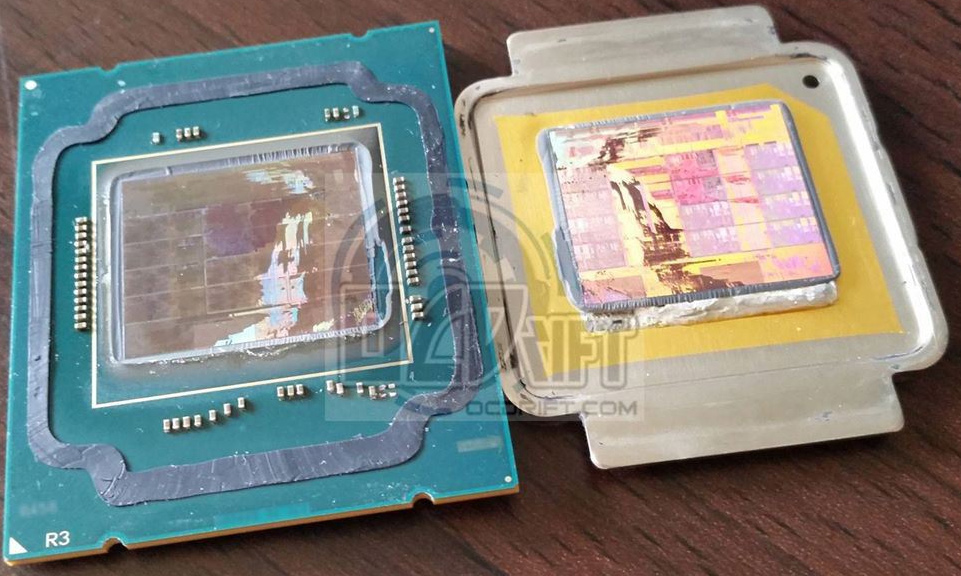Intel Corp.’s next-generation high-end desktop microprocessors called “Haswell-E” are still a couple of months away from their launch, but select enthusiasts have already managed to obtain them. While unfortunately we do not have a lot of ideas about performance of the upcoming chips, the first discoveries about the Core i7-5960X processor seem to be quite interesting.
OCDrift web-site has posted a picture of a “Haswell-E” processor with removed heat-spreader. While the removal clearly damaged the chip, it helped to make two important discoveries. Firstly, the Core i7-5960X processor uses a special alloy to solder the die to the heat-spreader, which is good for overclocking potential of the chip. Secondly, the die itself contains 12 cores with only eight activated.
While most probably it will be impossible to activate additional cores within the Haswell-E chips, it is noteworthy that they are there and therefore Intel can potentially release a desktop microprocessor with ten or even twelve cores. Such a processor will hardly make a lot of sense for desktop applications that benefit from single-thread performance.
Intel’s Haswell-E chips will be the company’s first processors to support DDR4 memory and will also be the company’s first desktop chips with up to eight cores.
Intel did not comment on the news-story.
Discuss on our Facebook page, HERE.
KitGuru Says: Since the Haswell-E shares the silicon with the Haswell-EP designed for servers, it is not surprising that it has 12 cores instead of eight. What remains to be seen is what happens to its overclocking potential because of that…
 KitGuru KitGuru.net – Tech News | Hardware News | Hardware Reviews | IOS | Mobile | Gaming | Graphics Cards
KitGuru KitGuru.net – Tech News | Hardware News | Hardware Reviews | IOS | Mobile | Gaming | Graphics Cards




why give you an extra 6 cores???? and then disable them !!!!!
what is this madness? are they there so when they are made they can pick the best performing 6 to enable?
because the die is based off the higher end xeon chips that probably will have 12 cores, and its not 6 more cores its 4 more cores, anyways its likely Haswell-E i7s failed the test for xeons, had defective cores disabled and certain features disabled, or Intel just needed more i7s
Wasn’t the 4960x an 8 core but with 2 core disabled too ?
I’m sure it’s not intel’s first time doing this.
Everyones been doing that sort of thing for years on GPU’s, CPU’s alike. its cheaper if they use the same production line than their more powerful chips and disabling cores for this than using a whole new production line. Also if those stronger chips have some dis functioning cores those can be disabled then used as the stable weaker chip.
CPU makers have been doing this for decades to increase processor yields. Any manufacturing technique is going to have a certain number of defective products. With a CPU, it could be a bad memory channel, a bad QPI link, some bad cache, a bad CPU core, etc. So, what Intel does is disable the bad parts and sells it as a cheaper chip. With Ivy Bridge, they only make 6 core, 10 core and 12 core CPUs, with the chips with some defects — or some good chips, if the process turns out better than anticipated — being sold as 4, 8, etc core CPUs. With Haswell-E, it sounds like they may be limiting the number of CPU masks they’re making, and concentrating more on disabling bad cores. There’s nothing wrong with the end processor, there are just bits and pieces of the silicon that aren’t being used.
Guarantee you these chips will be used for Xeons as well, with the extra cores activated.